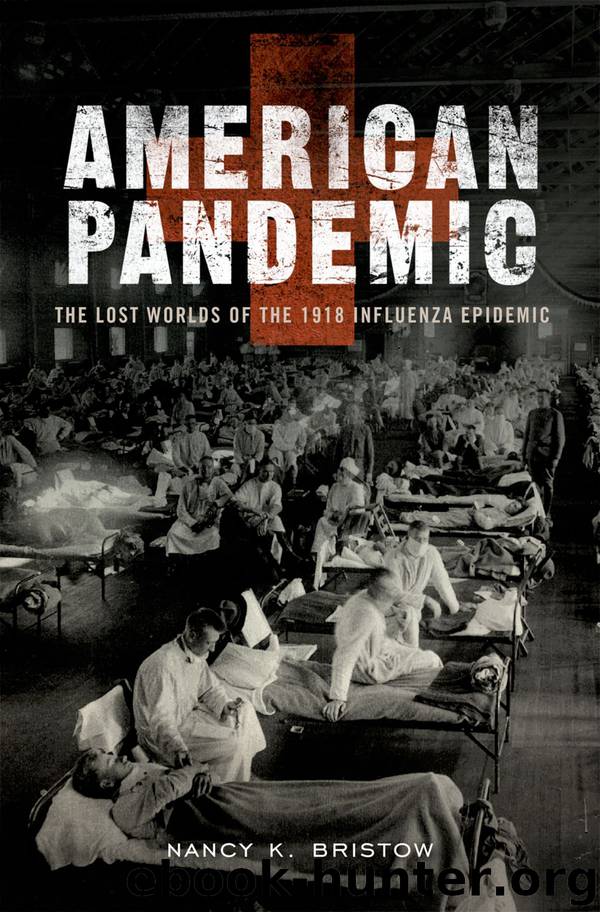American Pandemic by Bristow Nancy K

Author:Bristow, Nancy K.
Language: eng
Format: epub
Publisher: Oxford University Press, USA
Published: 2012-01-02T16:00:00+00:00
|| 5 ||
“The terrible and wonderful experience”
Forgetting and Remembering in the Aftermath
In a lecture before public health professionals in October 1919, Mazyck P. Ravenel, Professor of Preventive Medicine at the University of Missouri and a leader in the field, reviewed the profession’s work among American soldiers during the war and admitted to what he viewed as public health’s uneven record. Referring specifically to influenza, he conceded, “Any one [sic] interested in preventive measures, and wishing to demonstrate the efficiency of modern methods would be glad to pass this disease in silence.”1 Suggesting the epidemic had proven “comparable to the historical plagues of the past, which we are in the habit of connecting with the dark ages of medicine,” Ravenel noted that the death rates were sufficient “to demonstrate the ravages of this epidemic, and our lack of control over it.”2 Though recognizing that their protective efforts sometimes seemed to protect the troops from the disease, he nevertheless acknowledged that their successes were limited. “At best,” he concluded, “we must admit that no measures adopted controlled the course of the pandemic. It spread with lightning like speed, went where it listed, and ceased its ravages only when available material was exhausted. If any preventive measures prevailed they were local. We must confess that on the whole we made a dismal failure in our attempts to control the spread of influenza.”3 His seemingly chastened narrative was tempered by Ravenel’s suggestion that influenza and other “diseases spread by the secretions of the respiratory tract” constituted the toughest foe of public health efforts during the war, that they were, in fact, the “greatest weakness of the Army defense against disease and death by disease.”4 Even so, Ravenel acknowledged in its immediate aftermath the struggle the epidemic had presented to American public health efforts.
Two years later, Ravenel offered a significantly brighter assessment of the field’s work. By 1921 Ravenel had reached a pinnacle of professional success, the presidency of the American Public Health Association, and the occasion for his November lecture was the fiftieth anniversary meeting of the organization. In his lecture, entitled “The American Public Health Association, Past, Present, Future,” Ravenel acknowledged the challenges ahead for the public health movement, but ultimately emphasized what he viewed as its extraordinary accomplishments.5 “We were born at an opportune moment, and have lived in a period which for all time will be remarkable for its scientific achievement,” he suggested.6 Quoting the important leader in medical education, William Osler, on the advancements of the nineteenth century, he continued, “At last science emptied upon him [humanity], from the horn of Amalthea blessings which cannot be enumerated, blessings which have made the century forever memorable; and which have followed each other with a rapidity so bewildering that we know not what next to expect.”7 Ravenel proclaimed, “It is good to have lived in such a period, but it is better to have taken an active part in the events which have made that period notable, and this we can with confidence claim.
Download
This site does not store any files on its server. We only index and link to content provided by other sites. Please contact the content providers to delete copyright contents if any and email us, we'll remove relevant links or contents immediately.
| Administration & Medicine Economics | Allied Health Professions |
| Basic Sciences | Dentistry |
| History | Medical Informatics |
| Medicine | Nursing |
| Pharmacology | Psychology |
| Research | Veterinary Medicine |
Periodization Training for Sports by Tudor Bompa(8170)
Why We Sleep: Unlocking the Power of Sleep and Dreams by Matthew Walker(6618)
Paper Towns by Green John(5089)
The Immortal Life of Henrietta Lacks by Rebecca Skloot(4525)
The Sports Rules Book by Human Kinetics(4290)
Dynamic Alignment Through Imagery by Eric Franklin(4116)
ACSM's Complete Guide to Fitness & Health by ACSM(3989)
Kaplan MCAT Organic Chemistry Review: Created for MCAT 2015 (Kaplan Test Prep) by Kaplan(3939)
Introduction to Kinesiology by Shirl J. Hoffman(3725)
Livewired by David Eagleman(3683)
The Death of the Heart by Elizabeth Bowen(3551)
The River of Consciousness by Oliver Sacks(3538)
Alchemy and Alchemists by C. J. S. Thompson(3449)
Bad Pharma by Ben Goldacre(3355)
Descartes' Error by Antonio Damasio(3230)
The Emperor of All Maladies: A Biography of Cancer by Siddhartha Mukherjee(3064)
The Gene: An Intimate History by Siddhartha Mukherjee(3047)
The Fate of Rome: Climate, Disease, and the End of an Empire (The Princeton History of the Ancient World) by Kyle Harper(3003)
Kaplan MCAT Behavioral Sciences Review: Created for MCAT 2015 (Kaplan Test Prep) by Kaplan(2936)
